Introduction
Ecommerce sales are tough as it is.
With cart abandonment rates so high, it’s already hard to close a sale.
People add your products to their carts or bags, but that doesn’t mean you’ve sold product.
Let alone the fact that 98% of people won’t convert on their first visit to your store.
Which means you need powerful, effective remarketing to bring them back for a sale.
But average remarketing click-through rates are only 0.05%.
It’s tough to get people to your site, and even tougher to bring them back to buy.
But maybe that’s the problem. The focus isn’t where it should be when it comes to sales.
We’re always too focused on getting more customers, rather than improving the lifetime value of our current ones.
Brand-aware customers are much more likely to purchase from you.
Meaning we need to shift from the mindset of “more is better” to focusing on getting higher repeat purchase rates.
Shifting from pulling in as much traffic as we can to focusing on our existing customers.
The ones who’ve already purchased from you and know your brand!
In this post, we’ll show you how Greats built a powerful footwear brand with strong customer loyalty and a 50% repeat purchase rate.
Plus, we’ll show you how you can build a powerhouse of repeat customers, too.
How Greats built high lifetime value customers
Founded in 2014, Greats is a Brooklyn-based footwear company that offers top-of-the-line style at an affordable price.
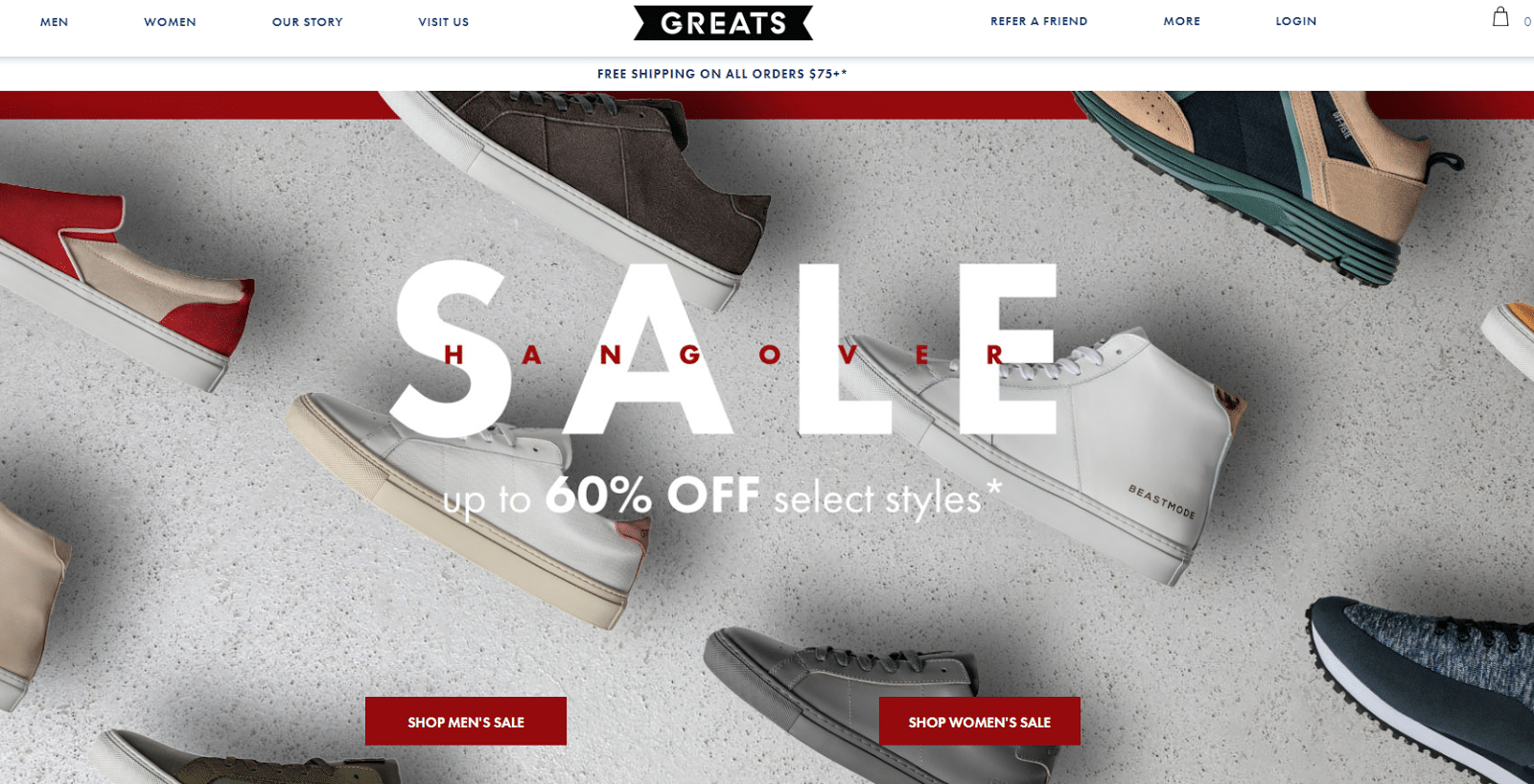
Co-founder of Greats, Ryan Babenzien, has built a loyal following with a 50% repeat purchase rate.
His customer lifetime values are off the charts.
Before co-founding Greats, Ryan held major marketing positions at top footwear brands like Puma and K-Swiss.
While in those C-Suite positions, he noticed that the traditional model wasn’t working as well as it had in the past.
The traditional model was failing.
He asked himself, “What if we launched a vertical brand in the men’s footwear space?”
And the rest is history.
The next step was raising capital. Getting the money to fund this new venture.
They went from pitching their basic idea to quitting their high-profile jobs in a single month.
Within just a few weeks they had a new Shopify website and started to design it for sales.
Soon, they noticed their business was taking off. Shoes were flying off the shelves. Social media was booming.
Coming from a shoe background, they knew that customer service was everything. So they quickly set up a Net Promoter Score to get insights on their customer-to-business relationship.
A Net Promoter Score is a management tool that helps gauge your customer satisfaction on a industry-standard scale.



The NPS splits respondents into three different groups:
- Promoters: those who score 9-10 on the NPS. These are loyal customers who refer others, creating sustainable growth at low costs.
- Passives: those who score 7-8 on the NPS. They are satisfied customers, but they aren’t evangelists preaching the good news just yet.
- Detractors: those who score 0-6 on the NPS. They typically aren’t happy customers and could even detract or damage your brand with negative reviews or word-of-mouth.
Greats put a massive focus on creating the best brand experience they could provide.
Making sure that each and every interaction was positive and helpful. They built their customer service around the philosophy of turning first-time customers into brand evangelists that would buy and share their brand for years to come.
Similarly, Amazon is a shining example of a great Net Promoter Score.
Ryan said that any score above a 50 would land a business in the A+ category. Amazon’s is 61.
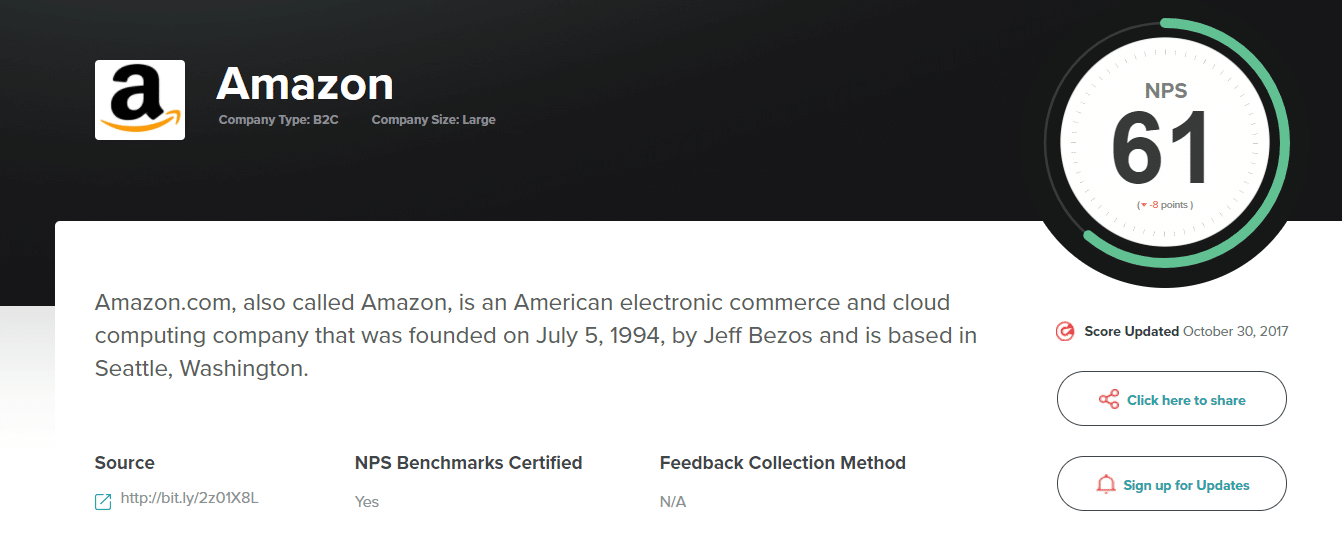


This is no surprise, as Amazon has a huge support base and high lifetime value customers.
They respond instantly with online chat. They offer free returns for anything purchased on their site.
The customer experience is great from start to finish, and they show great appreciation for their customers.
So, how did they Greats generate a 50% repeat purchase rate using this focus on customer service?
First, they placed customer service as their number one priority.
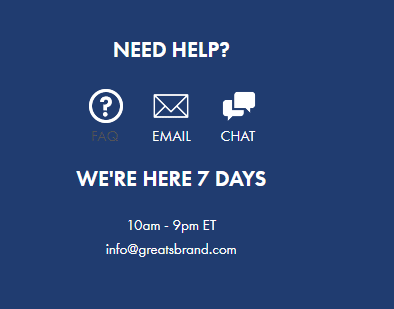


They’re available every day of the week to chat via email, phone or live chat.
And on their social profiles, they always respond with personalized messaging that shows a deep understanding and care for every customer:
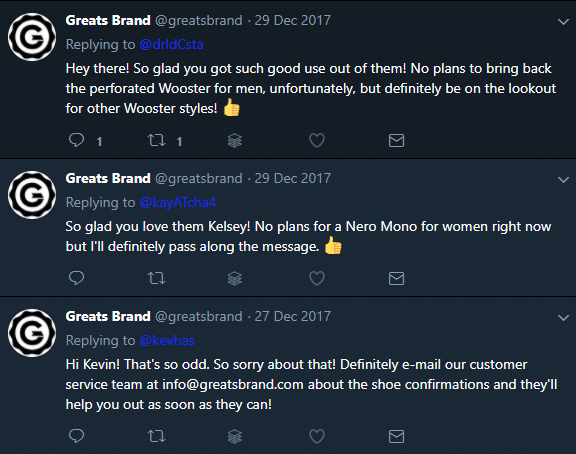


Plus, just like Amazon, they offer free product returns no matter what:
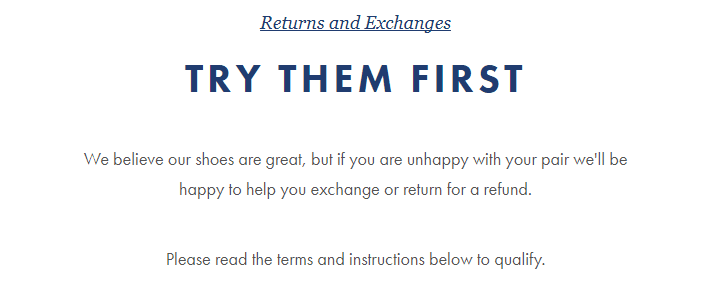


Ryan believes that customers dictate the rules, and leaving even a single customer unhappy or displeased with their brand is a recipe for disaster.
On top of great customer service, Greats focuses on brand positioning and sales emails that don’t focus on selling.
Ryan placed heavy importance on “selling without selling” and not annoying customers with purchase or offer-based emails.
With positioning, Greats focuses their content on more than just products.
For example, on their Instagram, they portray a specific lifestyle and image for their brand:
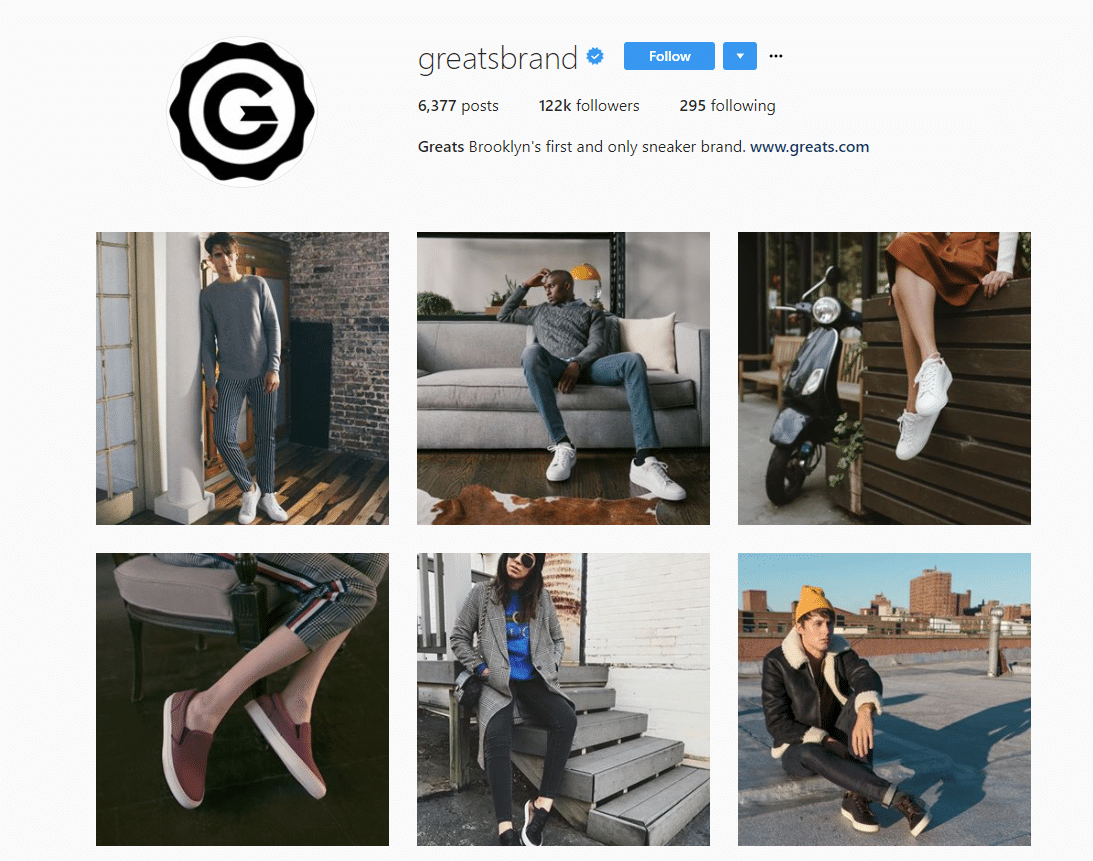


They subtly sell the shoes without asking people to buy.
Instead, they develop a brand position in the mind of consumers as a hip shoe company for urbanites.
Greats focuses heavily on building their repeat purchase rate. On taking advantage of the best source of income they’ve already worked so hard to obtain.
Here’s how any ecommerce brand an implement their practices to grow lifetime value and drive more sales.
Four steps to build high lifetime value customers and increase profits
Focusing on existing customers is critical for success in ecommerce. Here’s a four-step plan to increase profits by driving up customer lifetime values.
Step 1. Start collecting customer feedback and refining your product
The truth is, the best way to build high lifetime value customers and sell products is to have a product that’s top-of-the-line. A product that you believe in. One that you know is incredible.
As David Ogilvy once said, good products can be sold by honest advertising.



Why? Because the best advertisement is a good product. No matter how you portray it, your product needs to be killer if you want people coming back for more.
There is no secret hack or growth hack that you can use to get people to buy more. If your product sucks, they won’t come back.
And if you have hopes of building a brand that has loyal customers, selling once isn’t going to do it.
No matter how strong your retention gameplan is, your product has to sell itself. And the only way to achieve that is through customer feedback and constant refining.
Be sure to always keep up with your reviews on any store or website that you sell. If you don’t have many reviews, consider adding a small survey to the end of your checkout process:
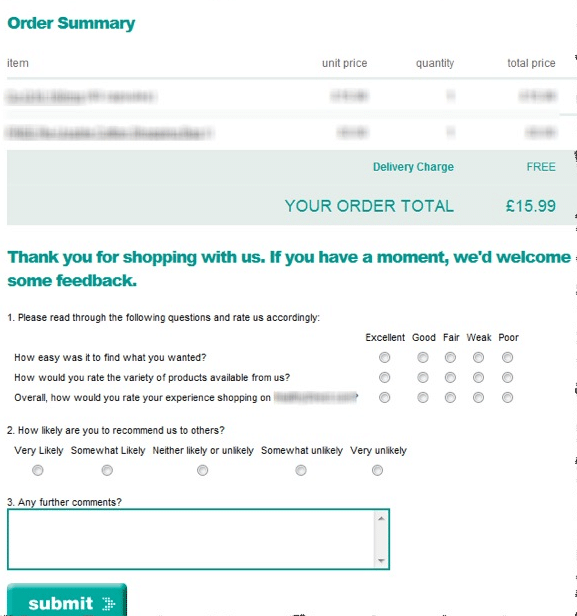


Don’t be afraid to email your customers asking them for feedback on your website, customer service or product in general.
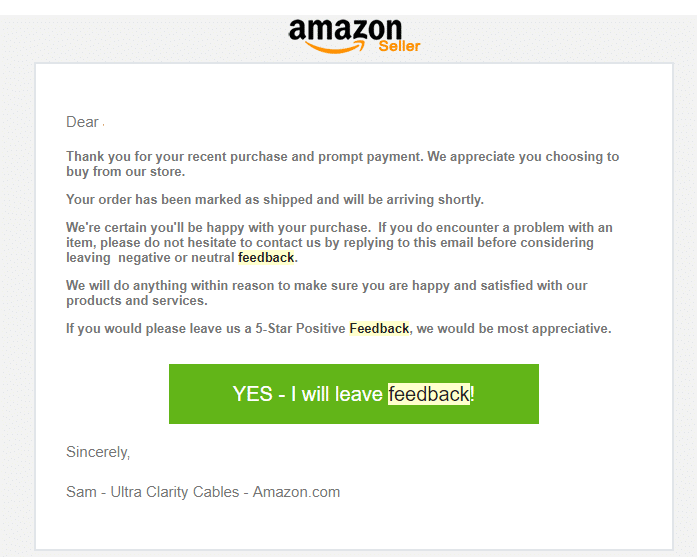


You should always have the mindset of refining your product to make it sell itself.
Once you’ve incorporated these efforts, you can start to collect feedback from the NPS.
The Net Promoter Score is a key way to understand how your customers interact with your business.
It shows you exactly how people view your brand, your customer service, and your products in general.
Generating a high NPS can result in huge increases in your customer lifetime value.
And that means big profits for years to come.
The NPS splits up respondents into three categories like we broke down earlier:
- Promoters
- Passives
- Detractors
Promoters are going to be the best of the best. The ones who actively promote your products for you!
An easy way to get started in measuring your NPS and understanding your customers is by setting up Delighted.
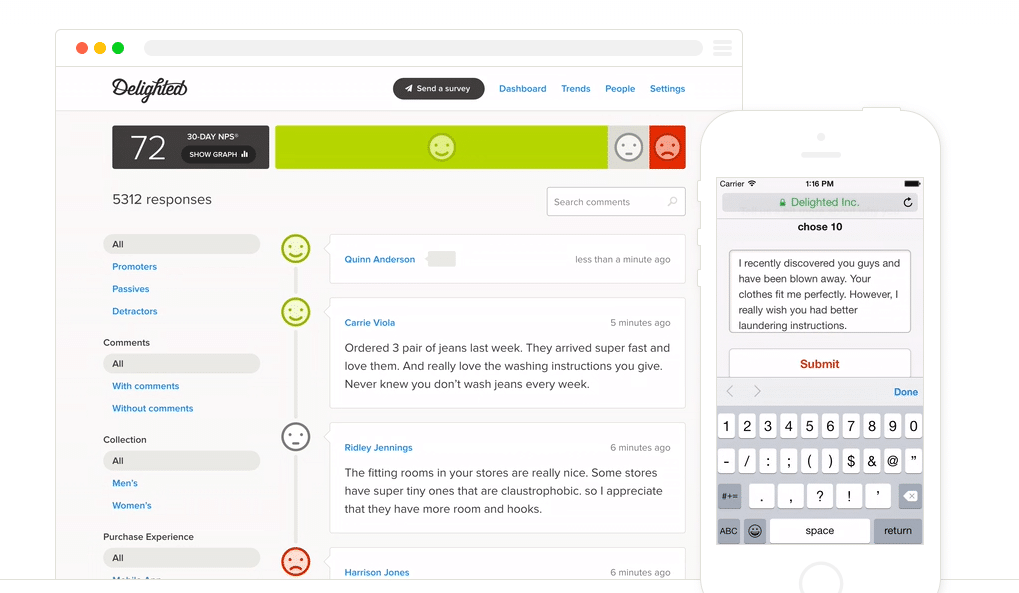


Delighted is a program that will help you automatically survey customers and get their feedback, creating a detailed dashboard of the results.
You can see exactly which customers gave good or bad feedback, creating an opportunity for you to make it right and turn them into promoters.
You can deliver surveys via SMS, email, or even directly on your website after a purchase has been made.
The survey is simple in nature, asking a single question:
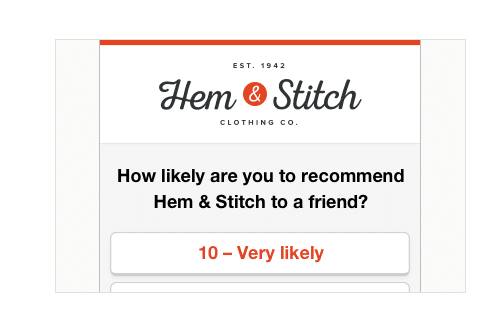


Then, a box at the end allows the user to describe their experience and highlight any good or bad experiences.
Next, feedback comes in real-time from customers, and you can see it directly in your own dashboard:
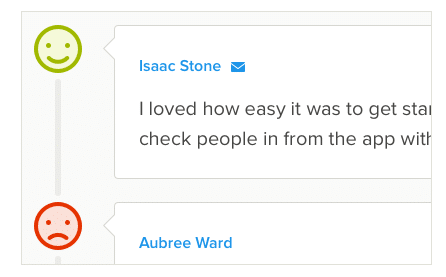


You can also see a list of each customer that purchased from you, and what their experience was:
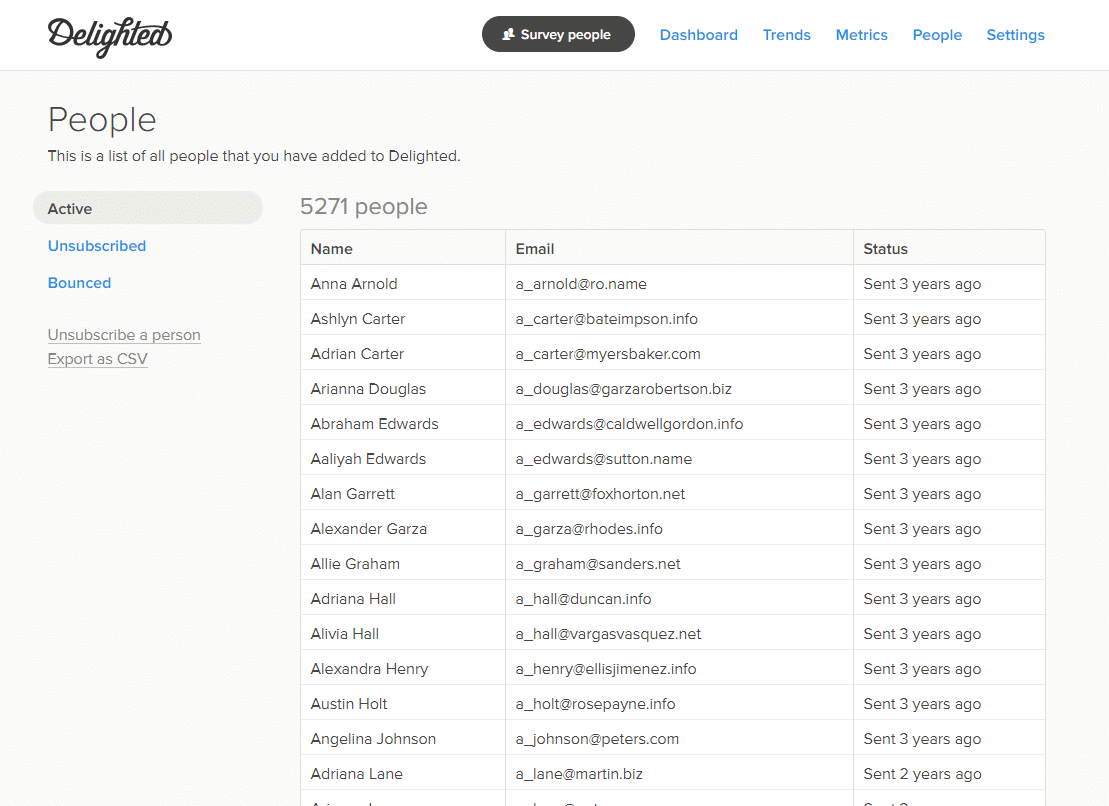


This is massively useful for crafting email lists and campaigns that seek to improve the relationship with customers who have lower scores.
To turn detractors into promoters.
If you run a site on Shopify, you can directly integrate Delighted to send a survey email after every purchase.
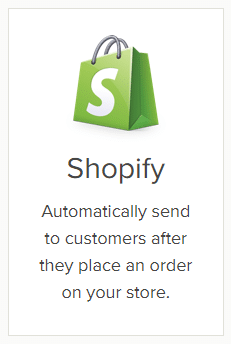


Delighted is one of the easiest ways to monitor customer feedback that directly correlates to the Net Promoter Score.
Once you have this set up, head to the dashboard and locate your trends:
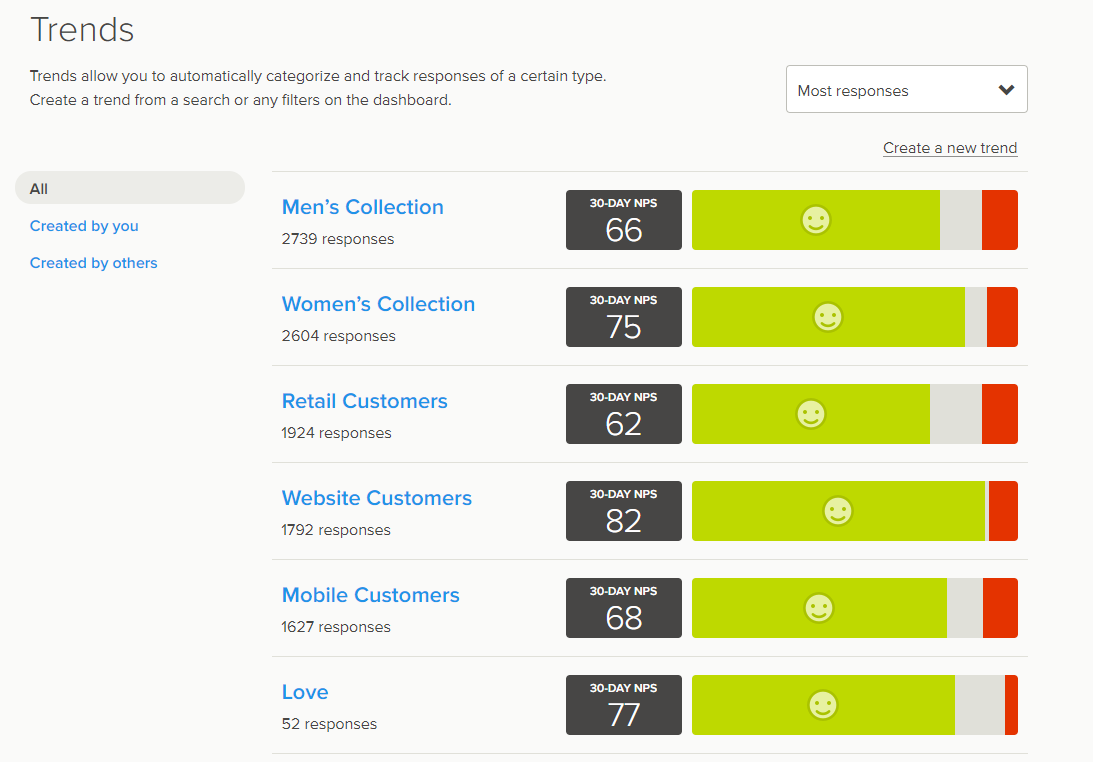


Trends will show you what customers have said based on each individual sector of your business.
For example, if you sell products to multiple target markets, you can see which experiences are and aren’t working.
Under the “People” section, you can see all of your active buyers that took the survey. Try exporting this survey and creating a new email list.
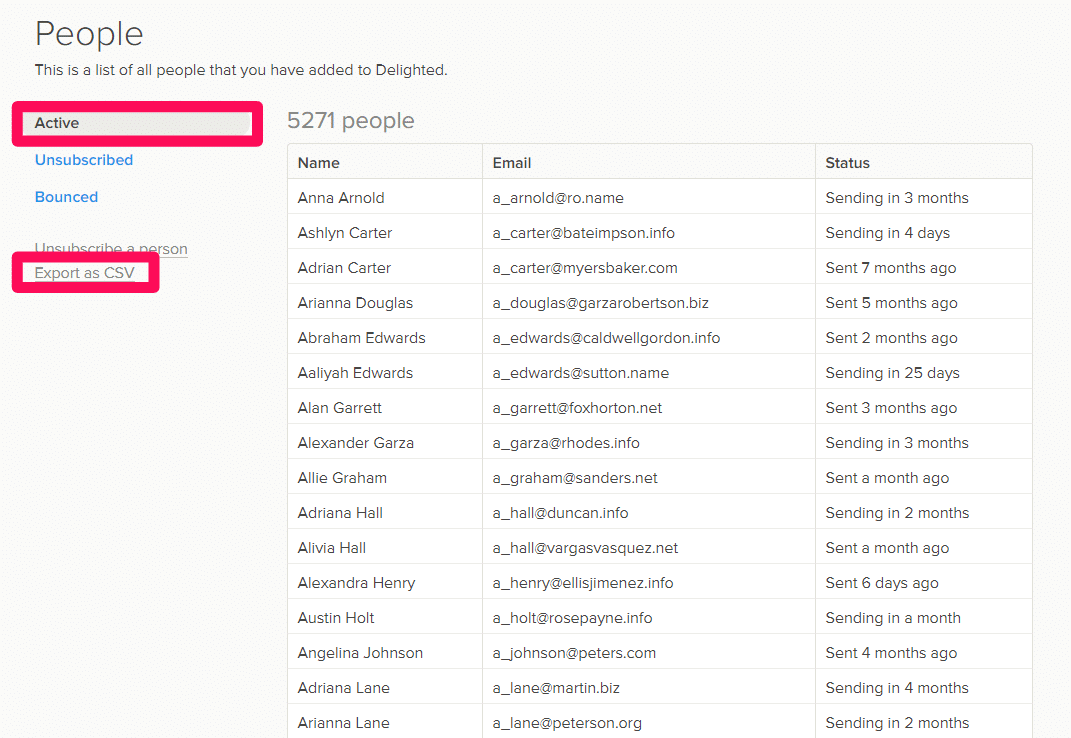


These customers are a great opportunity to develop a higher customer lifetime value.
In Step 4, I’ll show you how to “sell without selling” and turn these users into promoters fast.
For now, let’s jump into step two.
Step 2. Be active on popular social media channels for support.
Customer service generates sales.
We’ve all heard that before, but is it really true? Does a simple thing like live chat or answering a question faster actually drive or prevent sales?
According to an American Express Survey, 78% of consumers have ditched a potential transaction because of a bad experience.
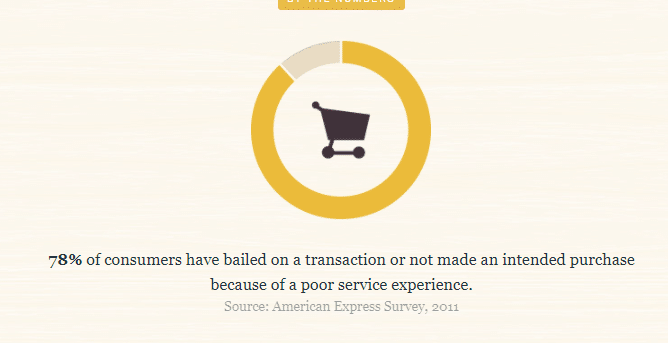


That same survey found that seven out of ten Americans were willing to pay more money to companies that had better customer service.
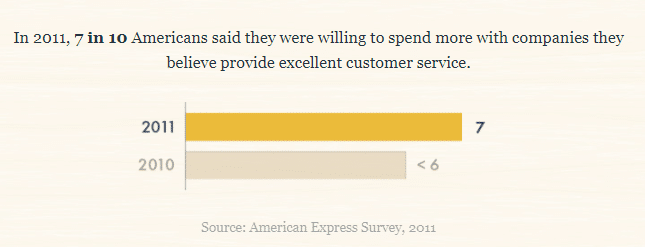


Ignoring customer service as a selling point is dangerous:
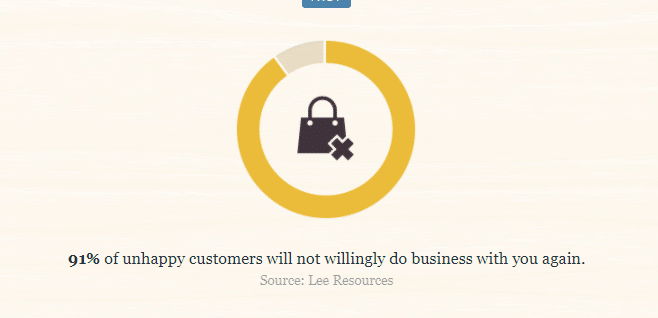


91% of dissatisfied customers will not buy from you again.
But there’s good news, too: resolving a complaint in the customer’s favor will almost always generate more business with them.
And one of the most popular networks for customer service today is Twitter.
Why? Because you can get responses fast.
All of the largest brands are taking advantage of Twitter as a medium for customer service:
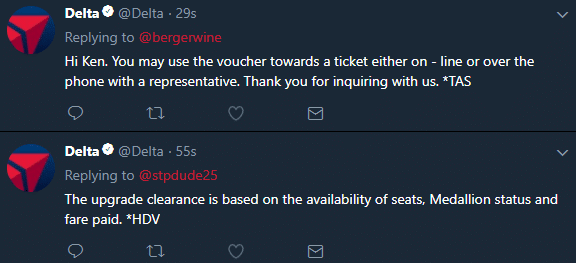


Greats employs the same strategy in their business today:



Focus on responding to customers fast, and giving them the best experience they can get.
Be sure to personalize each message you send by adding their name and any customer information you can find that isn’t confidential.
For example, did they recently buy a shirt? Ask them how they like it, how it fits, or if you can improve it.
Always personalize your customer service messaging.
Greats puts a large emphasis on their Twitter customer service to create customers who want to do business with them again.
Step 3. Develop a brand-positioning strategy.
One of the key ways that Greats built an ecommerce brand with a 50% repeat purchase rate is by developing a brand-positioning strategy.
From their Instagram to their website, you immediately can tell who the product is for. What their ethos is. What their target market is.
Brand positioning is often defined as the conceptual place you own in the consumer’s mind:
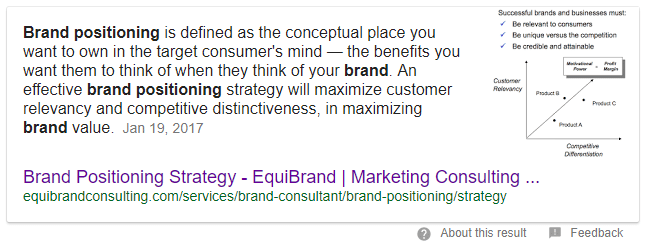


What comes to mind when you hear brand names like Nike or Amazon? The best athlete gear and everything from A to Z?
That’s brand positioning.
And Greats utilizes brand positioning in everything from their social media to email campaigns.
A great way to develop your brand positioning is to first outline your brand goals and target market.
Ask yourself a few big questions:
- Who is your product best suited for? What’s your target market?
- What is the brand ethos? In other words, what does your brand represent? Urban fashion? Upscale?
- What does your brand stand for?
In answering these questions, you should have the ideal vision of your brand.
For example, Greats portrays their brand position heavily with similar Instagram content:



What comes to mind when you view these images?
They all relate to urban, city-based fashion for a young generation.
That’s their brand positioning in the eyes of consumers.
Once you’ve crafted a solid brand position that you want to set in the minds of consumers, it’s time to create content around it.
Post on social media with content surrounding that idea. In your messaging and email campaigns, always be sure to tap into your company story.
Share what makes your company unique and what separates it from any other brand selling products like yours.
Step 4. Develop email campaigns that “sell without selling”
Taking your email list from earlier, it’s time to develop email campaigns that sell without actually selling.
This will increase the likelihood that these users turn into promoters fast.
Detractors or passives are only going to hurt your business.
If you want a higher repeat purchase rate, you need to develop a great experience for users from start to finish.
One of Ryan’s biggest tactics for turning passives and detractors into promoters and keeping promoters around is to sell without selling.
To create email campaigns that focus on lifestyle, positioning and useful content rather than just offer-based sales.
If you look in your inbox under the promotions tab, what do you see? Likely a huge list of “50% off!” subject lines.
People get the same offer-based emails daily from brands looking to make a fast sale.
But Greats focuses their strategy for emails to existing customers in a different way:
Creating value and brand loyalty.
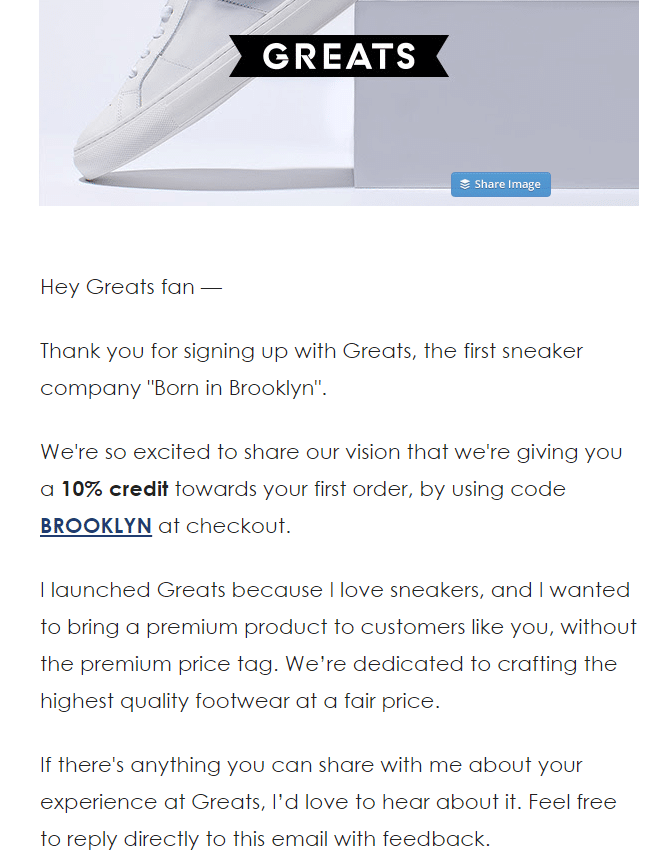


The first email you receive when signing up for their list comes directly from the Co-founder himself.
It again pushes the idea of positioning with “Born in Brooklyn.” It creates an urban, hip vibe that the company is looking to create in the eyes of consumers.
It subtly shares a 10% discount code that’s sandwiched between less aggressive text to shift the focus from selling.
The email also provides background story on the company to help position the brand, while also requesting more feedback for transparency.
Following in Greats’ footsteps, we’ve crafted a specific email template for you to use so you can turn detractors and passives into promoters ASAP:
Hey [First Name]!
Thank you for sharing your feedback on your last purchase experience. We greatly appreciate it!
As you may know, at [Company Name], we strive to [Company Mission].
And since you weren’t fully satisfied, we’d love to offer you a [coupon, discount, free product] to make up for it.
We pride ourselves on [end values that you can deliver for the customer, for example, good service, low prices, etc.].
Building this company from [company story], and turning into a [brand position], we love our customers.
Please let us know if there is anything else on your mind or anything we can do for you.
Thanks [First Name].
Sincerely,
[Your Name + Title]Use this template in your next email campaign to create better brand loyalty and increase the likelihood that existing customers will purchase from you.
Recap: TL;DR
Typical marketing playbooks to drive sales tell us one thing:
Cast a wide net and reel in as many fish as possible.
But that’s time-consuming and expensive.
When you’ve already got customers who have purchased from you, it’s your job to turn them into repeat customers.
Customers who will buy from your brand for years to come, and who will even share that brand love with their friends.
It’s about creating promoters who are evangelists for your company and products.
Greats did just that by focusing on the Net Promoter Score.
Start by using Delighted on Shopify to collect customer feedback.
Be active on social channels and offer every level of support you can.
Use social channels to position your brand, rather than to push sales.
Lastly, craft email campaigns targeted to your existing customers that focus on selling without actually selling.
Now it’s your turn
Sometimes we often neglect our most prized possessions in business:
The customers we currently have.
Follow in Greats’ footsteps, and you’ll be on your way to building an ecommerce brand with a huge repeat purchase rate.
What are your plans to focus more on existing customers? How will you drive up the customer lifetime value?

Comments